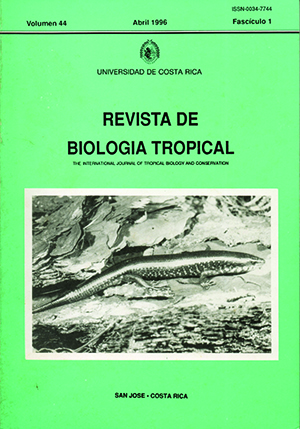Abstract
Composition and distribution of the continental ichthyofauna were studied in southem Quintana Roo and adyacent areas of Campeche and Belize, southeastern Yucatan Peninsula, Mexico, on the basis of 69 sampled 10ca1ities, as welI as the published information and the fish collection carried out by the Zoology Museum at the Quintana Roo Research Center (MZ-CIQRO P). Fishing gear included 2- and 20-m-Iong seine nets, 1- and 3-m-wide throw nets, hook, spear, hand.nets, and traps; we recorded parameters such as temperature, salinity and conductivity, transparency, depth, dissolved oxygen, bottom type and riparian vegetation. Most of the sites were visited in the rainy and the dry SeasODS. The inventory of continental fishes of Quintana Roo includes 85 species, 55 detected in the southem zone. Twelve are recorded for the first time in continental waters of the state: Anchoa colonensis. A. parva. Rhamdia laticauda, Atherinella sp., Strongylura timucu. Diapterus auratus, Eugerres plumieri. Stegastes leucostictus. Rivulus tenuis .• Phallichthys fairweatheri. Xiphophorus helleri. and Stephanolepis hispidus. Ouster analysis allowed distinction of the following four local ichthyofaunas, sorted by decreasing distance to the coast: (1) Zohlaguna Plateau, sorne 250 masl, with relatively cool waters; (2) Hondo River and bordering water bodies, such as freshwater cenotes, wetlands, pools and creeks; (3) Center-Northeast Zone, including the brackish lalce systerns of Bacalar, Guerrero and Ubero, as well as the wetlands around the Bay of Chetumal and freshwater lakes such as Vallehermoso; and (4) Southem Caribbean coastal lagoons. where salinity varies regularly. Ichthyofauna (1) is characterized by the occurrence of X. heUeri and Rhamdia guatemalensis and the frequency of Heterandria bimaculata and Poecilia petenensis; (2), by the frequency of primary fishes such as Hyphessobrycon compressus and Rhamdia laticauda, as well as Ophisternon aenigmaticum; (3) by peripheral fishes, such as Arius assimilis, Gobiomorus dormitor and Anchoa colonensis; (4), by a siguificatively greater richness, due to the dominance of marine fishes of the farnilies Gerreidae, Lutjanidae, and others, which utilize mangroves as nursery or feeding grounds. Even though the fish distribution within the study area follows essentially ecologica1 factors, the decrease in neotropica1 or primary fishes from Belize to Sian Ka'an shows the importance of historica1 factors on a slightly larger geographica1 scale.##plugins.facebook.comentarios##

This work is licensed under a Creative Commons Attribution 4.0 International License.
Copyright (c) 1996 Revista de Biología Tropical
Downloads
Download data is not yet available.


